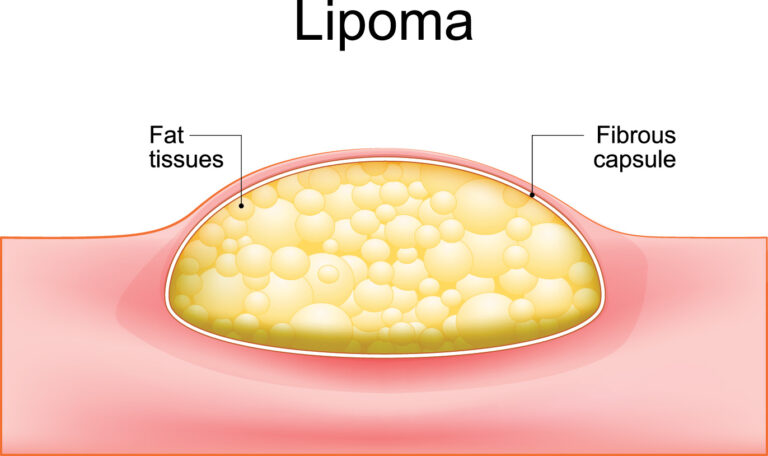A lipoma is a small lump of fatty tissue that usually grows under the skin. Lipomas feel rubbery and move when you touch them. Lipoma removal involves either surgical removal or liposuction.
Lipoma Removal Surgery Overview
- Surgery Time: 20-45 minutes
- Anaesthetic: Local
- Hospital Stay: Same-day
- Dressing and Garments: Stitches and dressing for 7 to 10 days
- Time Off Work: Up to 1 week
- Exercise: 2 weeks
- Mobile: Same day
- Washing: Following day
- Sleeping Position: Avoid putting pressure on affected area for 1-2 weeks
- Full Recovery: 2-4 weeks
What is a Lipoma?
Lipomas are noncancerous growths that develop under the skin. Lipomas are rarely a cause for concern and don’t require any treatment.
Lipomas can occur anywhere in the body, including:
- Neck
- Back
- Shoulders
- Arms
- Thighs
- Hands
Lipomas are most commonly found on the upper extremity. Lipomas are usually classified as benign tumours. It’s important to see your GP if you notice any changes to the skin around the lipoma since a lipoma can sometimes look like a liposarcoma, a rare cancer.
Lipomas are mostly small, with many not reaching a size larger than 2 cm. Some lipomas, however, grow so large and are known as giant lipomas. A large lipoma is mostly larger than 5 cm and can occur anywhere in the lower body.
Lipomas are usually distinguished by how the tissue appears under the microscope. The various types include:
- Conventional lipoma: This is the most common type of lipoma.
- Atypical lipoma: These lumps contain many fat cells and deeper fat.
- Myelolipoma: Unlike conventional lipomas, these produce white blood cells.
- Hibernoma: This type of lipoma contains brown fat instead of white fat in conventional lipomas.
- Pleomorphic lipoma: The fat cells in these lipomas vary in size and shape.
- Angiolipoma: This lipoma contains fat cells and many blood cells.

Lipoma Causes: What are They?
The cause of lipomas is usually unknown. However, genetics and family history may contribute to the development of lipomas for some people.
Lipoma Treatment: What Happens During Lipoma Removal?
Lipomas are harmless, and most people learn to live with them. However, there are times when you may require lipoma removal. You may be a great candidate for lipoma removal if:
- The lipoma affects your confidence, especially when it’s in an area where people can see it immediately.
- The lipoma is very large
- It is causing you pain and discomfort
- It is beginning to interfere with normal body functions
- The doctor can’t confirm if you have a lipoma or another type of tumour
Lipoma Removal Surgery
Surgery is usually your best bet when it comes to lipoma removal. However, there are other less invasive procedures your doctor will talk to you about. The first method involves the doctor making a small incision and then squeezing out the lipoma. This is done under local anaesthesia, and you should be able to go home the same day and back to work the next day.
Generally, lipoma removal should take between 20 to 45 minutes. If the lipoma is large, the doctor will need to make a larger incision. Sometimes, the doctor might opt to remove the lipoma through liposuction. They cut into the lipoma lump and insert a thin tube through the incision. The tube will then suck the fat cells out of the body.
Squeezing out the lipoma and liposuction are all effective, but the lipoma can still come back. Your doctor might opt for surgery to prevent that, especially if the mass is large. For this, the doctor makes an incision in the area, removes the lipoma in its entirety and then closes the incision with stitches.
How Long Does a Lipoma Removal Take?
Lipoma removal is a relatively straightforward operation. The procedure is carried out under local anaesthesia. How long the removal takes depends mainly on the location and size of the lipoma. With that in mind, smaller lipomas in areas like the forearms take as little as 20 minutes to remove. Larger and deep-seated lipomas can take up to 2 hours to remove. That’s because the surgeon has to remove a lot of tissue and reconstruct the areas for improved aesthetics.
How Long Does It Take to Recover from Lipoma Removal?
Recovering from lipoma removal surgery doesn’t take long, with most people returning to work after 1 to 3 days following the procedure. However, recovery might take longer if the lipoma is located in areas like the foot or is larger. Generally, you can expect recovery to take between 2-4 weeks.
Lipoma Removal Risks
Lipoma removal risks include:
- Poor scarring
- Infection
- Bleeding
- Swelling
- Pain
- Risk of nerve damage
Lipoma Removal Near Me: Lipoma Removal London
Are you considering lipoma removal surgery in London? The Harley Clinic is a premier cosmetic surgery facility located on Harley Street, London.
Book a free consultation today to discuss your lipoma removal options.
Further Reading:
- What’s the Difference Between Trigger Finger vs Dupuytren’s Contracture?
- How to Release a Stuck Trigger Finger
- What are Two Conditions that are Often Misdiagnosed as Carpal Tunnel Syndrome?
- How Long Do Ganglion Cysts Last?
- How to Sleep with Carpal Tunnel Syndrome
- 5 Common Types of Hand Surgery
- Can You Remove Acne Scars Permanently
- What Makes You Look Older? 10 Unhealthy Habits to Avoid
- 6 Useful Skincare Tips for Men This Winter to Combat Dry and Dull Skin
- 5 Ways Not Enough Sleep Can Impact Your Skin
- What Does a Lipoma Feel Like?










